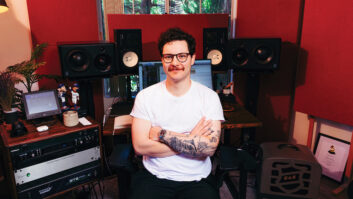That “next big thing” rock vocalist is due in your studio in an hour to record a demo, but the drummer didn’t show up to lay down the backing tracks. Do you cancel the session? No, just launch Submersible Music’s DrumCore and drag-and-drop a few bone-crushing loops into Pro Tools.
Submersible Music DrumCore lets you drag-and-drop MIDI patterns and audio loops into your DAW.
DrumCore puts a large selection of mainstream pop and rock beats on your hard drive, all of which are played by real drummers — and not just ordinary drummers. Providing more than 8 Gigabytes of loops are Alan White, Ben Smith, Jeff Anthony, John Bishop, Matt Sorum, Michael Shrieve, Sly Dunbar, Tony Braunagel, Zoro and the hip hop duo Ned Douglas/DJ Syze-Up.
The recordings are done in stereo at 48 kHz/24-bit. While great mics and consoles were used for the sessions, the emphasis is on taste and variety, not variations in mic position and other such tweaks. Some selections have more room ambience than others, but it’s never overbearing.
A GUI DELIGHT
Managing such a massive amount of data is easy thanks to DrumCore’s database orientation, which lets you view the library by drummer or by style. The results can be filtered by tempo (or tempo range) and other parameters. The best-represented styles are alternative, funk and rock, to which several drummers contribute. The long list of beats in the reggae and hip-hop categories is due mostly to the presence of a single drummer who specializes in that style. Country, ballad and dance hall are included in the database, but the offerings are meager. Blues, jazz, Latin, New Orleans, R&B, ska and world music average half-a-dozen selections each.
The beats are played at a variety of tempos, usually separated by 5 bpm, enabling you to find something that works with a minimum of time stretching. The pattern and sticking often changes a little from one tempo to another, as you’d expect of real drumming. Characteristic fills are also included for most of the styles. A more-or-less typical offering, Sorum Skippy, provides five or six basic beat variations and three to five fills, all of which are separately recorded at every tempo from 90 to 175 bpm, plus about 20 MIDI files. (Not all of DrumCore’s drummers provide such a wide tempo range.)
BEAT SOUP
Creating a track for your session couldn’t be easier. Both MIDI patterns and audio loops can be dragged and dropped into your favorite DAW from DrumCore’s cheerful orange interface. Another option is to “Gabrielize” (Submersible’s term, not mine) either the audio or the MIDI, a process that shuffles the rhythm around and may even play short snippets of audio backward, all under the control of secret algorithms. The results of Gabrielizing are often silly, but if you click the button 10 or 20 times, you may get something genuinely useful.
I grabbed a funky jazz shuffle and matching fill and parked them in Cubase SX tracks. Next, I laid down an acoustic bass line in Spectrasonics’ Trilogy, added some piano chords in Native Instruments’ Kontakt using SampleTekk’s White Grand and slapped a little M-Audio WizooVerb on the piano. You can hear the results at www.mixonline.com (drumcore shuffle.mp3). Any deficiencies in the realism of the ensemble are strictly due to my musical ineptitude, not to DrumCore.
If the loops and fills don’t do the job, you can try the MIDI-based patterns. Select any of the 38 factory drum kits to play them or use your own General MIDI — compatible kit. Choosing a kit that matches the drummer will give you a sound that’s close to the audio recording, but obviously not the same.
WHAT’S THERE, WHAT’S NOT
DrumCore gives you loops played by real drummers in a computer-friendly format that doesn’t force you to shuffle through a bunch of CD-ROMs. On that count, it is a winner; however, there are some things you should be aware of that may or may not be an issue with your setup.
For instance, technically, DrumCore is ReWire-compatible, but as it has no internal pattern sequencer, the main advantage of the ReWire connection is being able to monitor DrumCore through your DAW’s mixer. A secondary advantage is that you can send MIDI to DrumCore via ReWire to play the kits. I was only able to get DrumCore’s transport to start in sync with Cubase under ReWire when playback started at bar 1, beat 1. Starting at a later point in the song caused DrumCore to run half-a-beat late. DrumCore does not time-stretch beats itself; that chore has to be handled by the host program.
DrumCore has a kit editor to create your own kits for MIDI playback, but the program lacks most of the features found in drum kit plug-ins such as Native Instruments’ Battery — amenities like filters, envelopes and multiple outputs. Velocity crossfading is supported, but that’s about it. The kit editing is really just a bonus.
All in all, the sound and versatility are first-call. If quickly creating great-sounding bed tracks is your goal, then DrumCore may be just the ticket for your production room.
Price: $249; add-on DrummerPacks, $79.99 each.
DrumCore, 206/342-2331, www.drumcore.com.
Jim Aikin writes regularly for Mix, Electronic Musician and other music magazines.







